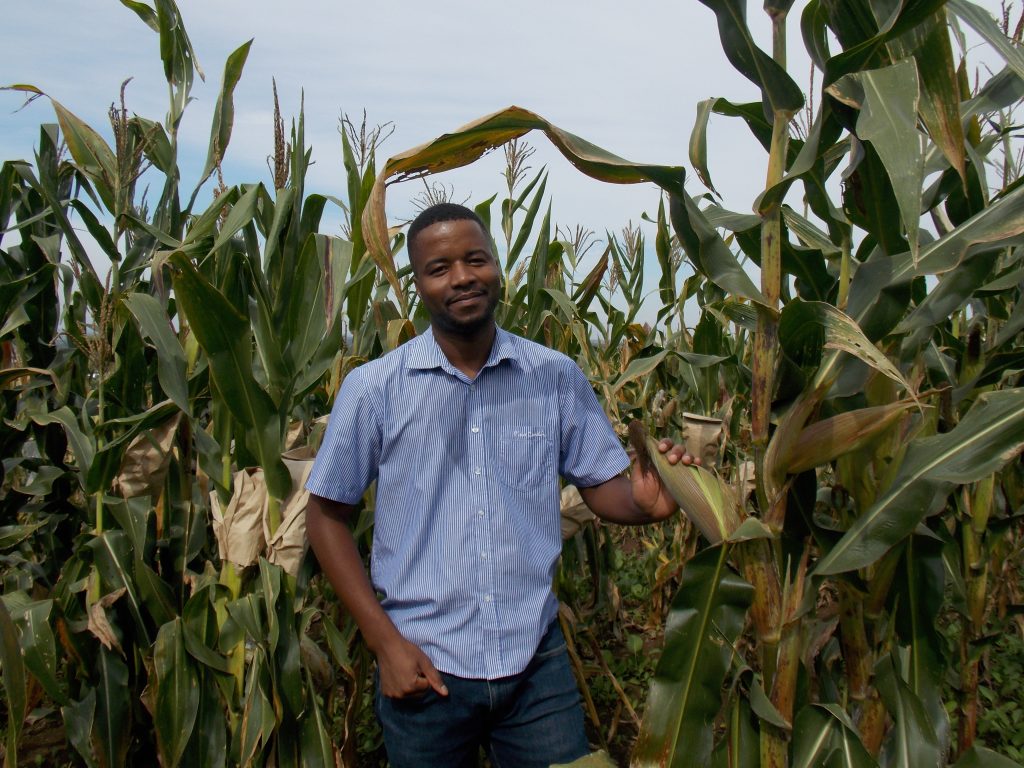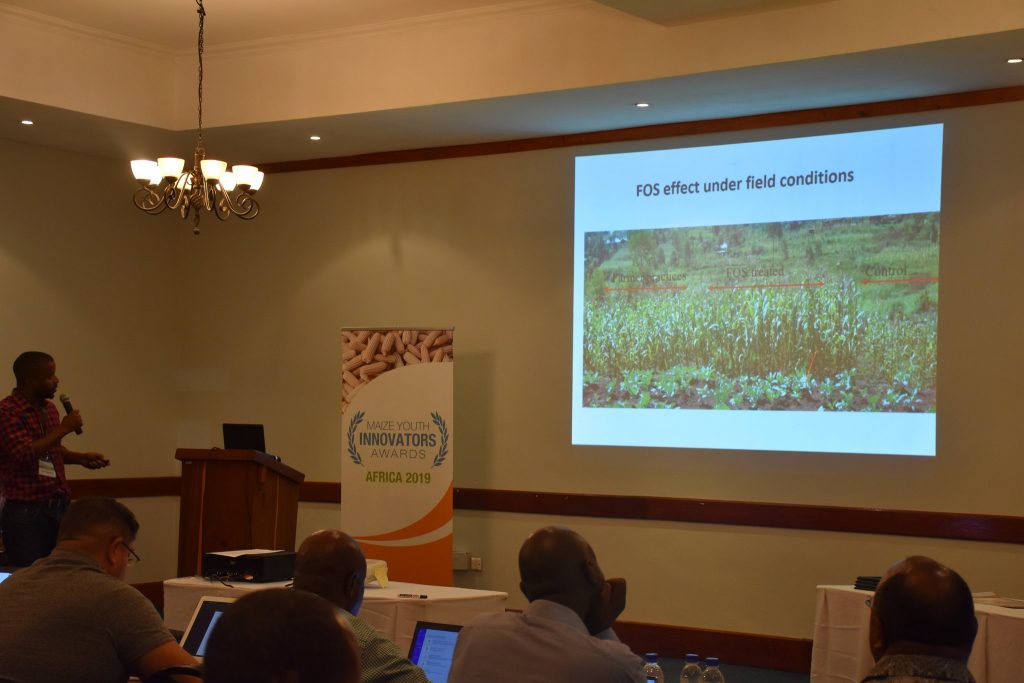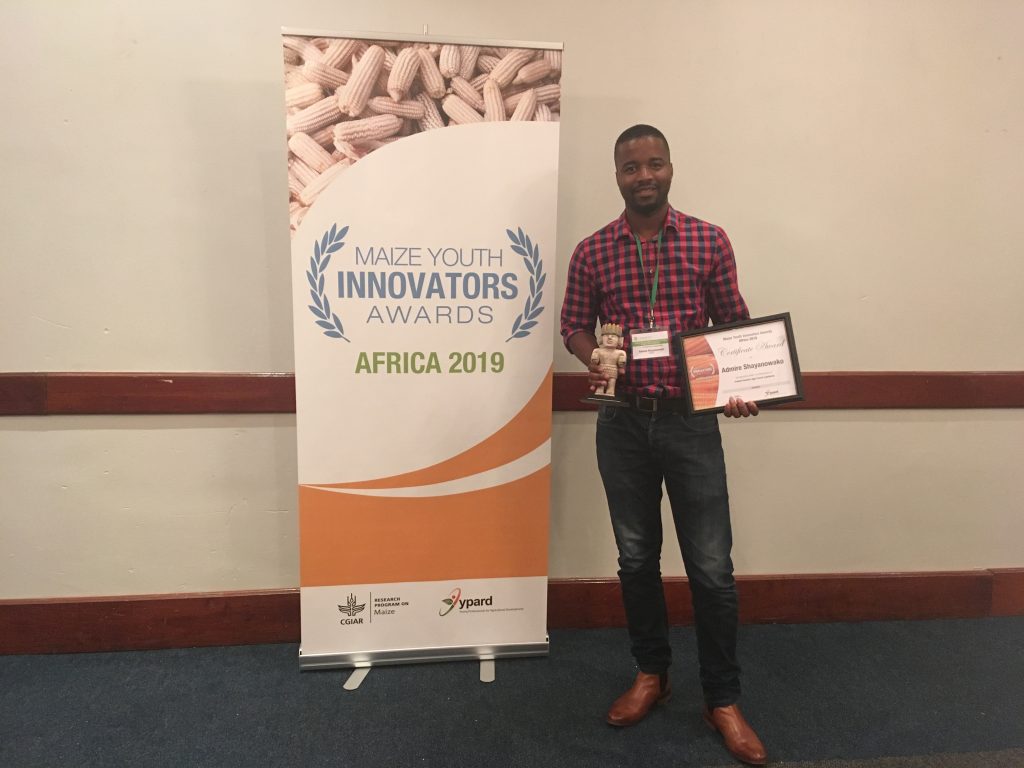
Increasing maize resistance to parasitic weeds: Admire Shayanowako
By Jennifer Johnson
Admire Shayanowako is no stranger to agriculture or the problems that smallholder farmers in Africa face. The 31-year old maize researcher grew up on a small farm in Zimbabwe where his family was constantly plagued by parasitic weeds. Now based at the University of Kwazulu Natal in South Africa, he is working on biocontrol agents and maize genetic resistance against Striga, also known as “witch weed”. He was recently recognized for his innovative research as one of the winners of the 2019 Maize Youth Innovators Awards – Africa, in the category of “researcher” at an awards ceremony in Lusaka, Zambia on May 9.
These awards, an initiative of the CGIAR Research Program on Maize (MAIZE), recognize the contributions of young women and men below 35 years of age who are implementing innovations in African maize-based farming systems. This is the second year of the awards, and the first time to be held in Africa. We recently sat down with Admire to discuss his research, inspiration and plans for the future.

Q: What inspired you to pursue a career in agriculture?
A: I grew up in a mining town. My dad was a miner, and to supplement some of his income and feed the family we engaged in agriculture. I didn’t enjoy it, as it meant that my play time was dedicated to producing food. What I resented most was a weed with thorn-like seeds that hurt terribly if you stepped on it barefoot. During harvest, my skin would also react to the “itch grass” growing in our fields—it was a horrible experience. I resolved never to have anything to do with agriculture. In high school I focused on the sciences, hoping to become an engineer or doctor, but in University my only option was agriculture.
My first internship was with the International Maize and Wheat Improvement Center (CIMMYT) under maize breeder Cosmos Magorokosho, where I was trained in all the basics of breeding, and surprisingly I enjoyed it! I felt inspired seeing everything the breeders had achieved in their lives. After I finished my undergraduate degree, I entered my family farming business, growing seed. My interest in agriculture began to grow. Unfortunately, the second year of the business our seed crop was destroyed by a wildfire and we lost everything.
I received a scholarship to study my master’s degree at African University and got a job helping smallholder farmers build resilience through seed systems and agronomy. During field visits I saw the problems people faced with parasitic weeds and wondered why more work wasn’t being done to breed for resistance. I took my idea to Professor Mark Laing and Professor Hussein Shimelis at the University of Kwazulu Natal and did my Ph.D. with them on parasitic weeds.
Q: Tell me about your research project.
A: Striga had long been a problem in my community, and it is a nasty parasite. As a small child I thought it was just a beautiful flower and envied neighbors that had more of it in their maize fields than we did, but I soon learned that it was a parasitic weed that could greatly reduce maize yields.
However, there is a soil fungus called Fusarium oxysporum f.sp. strigae that works as a natural biocontrol agent. We isolated the fungus that could be used to inoculate maize plants against Striga. Then, we got a call from the United States—Professor David Sands at Montana State University was working on enhancing the performance of Fusarium-based biocontrol agents against parasitic weeds, and had received funding from the Bill and Melinda Gates Foundation to train scientists. I went to Montana, where my knowledge on the chemical basis of this fungus greatly improved.

I returned to South Africa, and we selected candidates from local landraces and open-pollinated (OPV) maize varieties, as we wanted to target the poorest farmers who typically grow these varieties. We started looking into the genetic mechanisms controlling Striga resistance in maize, and a grant from Biosciences eastern and central Africa-International Livestock Research Institute (BecA-ILRI) supported our use of genomic tools in breeding. We also received a significant amount of inbred lines from the International Institute for Tropical Agriculture (IITA) to support our selection panel. We are now going into what really is the genetics behind Striga resistance in maize, and I am training other young scientists working on Striga resistance breeding and biological control.
Q: What do you hope will be the future of this project?
A: As the biological control agent is very easy to produce, we would like to see many small factories throughout Africa producing it so that we can release this technology into the hands of the farmers so they can manage Striga in their fields in an efficient way.
Q: What advice do you have for other young people interested in pursuing careers in agriculture?
A: All I know is that agriculture appears to be a dying industry. We as young people need to take charge of our food production, and develop innovative ways to feed the growing world population.

2019 MAIZE Youth Innovators Awards, Africa, Maize, maize breeding, MYIA 2019, South Africa, Striga, Zimbabwe
